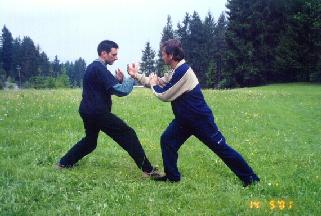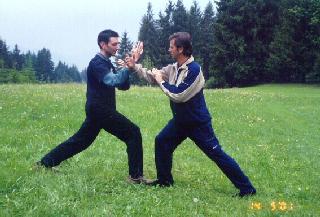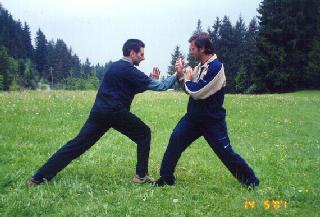TECHNIQUES AND SKILLS OF
TAIJIQUAN PUSHING HANDS

Editorial Note: This is originally meant to be a private webpage for students of Shaolin Wahnam Institute. Nevertheless, as there is not much information on Pushing Hands and Striking Hands although they are crucial aspects of Taijiquan, some explanation is given so that other Taijiquan practitioners may also benefit.
"Pushing Hands", known as "Tui Shou" in Chinese, is a very special feature of Taijiquan. It is however not unique because this special training method is also found in Wing Choon Kungfu, where it is known as "Sticking Hands", and in Wuzu (or Goh Chor) Kungfu, where it is known as "Kneading Hands".
"Pushing Hands" is excellent for training combat skills, but by itself it does not enable the practitioners to fight effectively. To do so, they have to progress to "Striking Hands", known in Chinese as "Da Shou", where the practitioners apply Taijiquan techniques for combat. "Pushing Hands" and "Striking Hands" are complementary, the former focuses on developing skills and the latter on applying techniques.
Because the emphasis is on skills, not many techniques are used in "Pushing Hands". Indeed in a normal Pushing Hands session, only the "peng" and the "an" techniques -- warding off and pushing -- are used, yet with just these two techniques initiated exponents can enjoy "Pushing Hands" for hours while developing very useful combat skills.
This is the main reason why "Pushing Hands" is seldom explained in books, including Taijiquan classics. When it is explained, only a few illustrations and just a few words are given. Actually that is all it needs.
Hence in a book of a hundred pages, only a few pages are devoted to "Pushing Hands", whereas seventy or eighty pages can be devoted to pictures and descriptions on the forms of Taijiquan. This can easily mislead uninformed students to spend too much time on forms and little or no time on "Pushing Hands".
In this and subsequent webpages, many pictures are given -- much more than are normally found in Taijiquan literature -- so as to help students to have some idea about "Pushing Hands". Yet, they must realize that no matter how many pictures are given and no matter how well they can learn from the pictures, they can only touch the surface.
If they wish to enter the depth -- to experience the subtle joys in practising "Pushing Hands" as well as to apply its skills for combat -- they have to learn personally from a master who teaches "Pushing Hands" as a means to combat efficiency.
Those students who believe they can learn anything from books or videos, may stubbornly refuse to acknowledge this fact. It may suffice to give just one example to verify the fact. One fundamental objective of "Pushing Hands" training is to develop sensibility, known figuratively in Chinese as "ting jin" or "hearing force" (with the arms). Even with his eyes close, an expert in "Pushing Hands" knows not only the movements but also the intentions of his opponent. How would you train this "hearing force" from books or videos?
The sequence below is aimed at training the following four fundamentals skills:
- Sensibility, or "ting jin" ("hearing force")
- Energy flow.
- The skill of following.
- The skill of leading.
You should practise this basic sequence for at least three weeks, the bare minimum, before proceeding to the next sequence.

Two exponents, Javier and Riccardo, at their "peng" position. Javier is a Taijiquan instructor for Shaolin Wahnam Institute in Spain, and Riccardo a Taijiquan instructor for Shaolin Wahnam Institute in Italy.

Javier gently moves his right arm forward into Riccardo.

Riccardo "sinks" his body backward to "swallow" Javier's force, and deflects Javier's arm to the right in a smooth circular movement.

Following the circular movement, Riccardo moves his right arm forward into Javier. Sensing Riccardo's forward movement, Javier "sinks" backward to "swallow" Riccardo's force
The sequence is repeated many times. "Many" here can be "ten", "a hundred" or "a thousand", depending on your developmental stage.
This fundamental "Pushing Hands" sequence is shown below in clockwise direction.

|

|

|

|
Note to shaolin Wahnam students: The above sequence is shown in the "advanced" mode. In the basic mode, the exponents do not move their legs and body; they only move their arms. Make sure the left arm is "alive".
Training Points
- Do not use strength. This is very important.
- Sense your partner.
- Later when you have become more proficient, you may close your eyes.
- Follow your partner's movement.
- Later, lead your partner subtly, without his knowing if possible.
- Going to Wuji and feel internal force building up.
- Be relaxed, calm and pleasant.
Taijiquan Pushing Hands
-
Series 1 -- Basic Techniques and Skills
-
Series 2 -- Front Attacks and Defence
-
Series 3 -- Right Side Attacks
-
Series 4 -- Left and Back Attacks
-
Series 5 -- Continuous Attacks
-
Series 6 -- Confusing Attacks
-
Series 7 -- Instantaneous Counters
-
Series 8 -- Tactic of Interception
Taijiquan Striking Hands
-
Series 1 -- Basic Striking Attacks and Defence
-
Series 2 -- Seeking Advantages in Striking Attacks
-
Series 3 -- Basic Kicking Attacks and Defence
-
Series 4 -- Seeking Advantages with Kicking Attacks
-
Series 5 -- Felling Attacks and Defence
-
Series 6 -- Reversing Falls
-
Series 7 -- Gripping Techniques
-
Series 8 -- Counters against Gripping Attacks
LINKS
